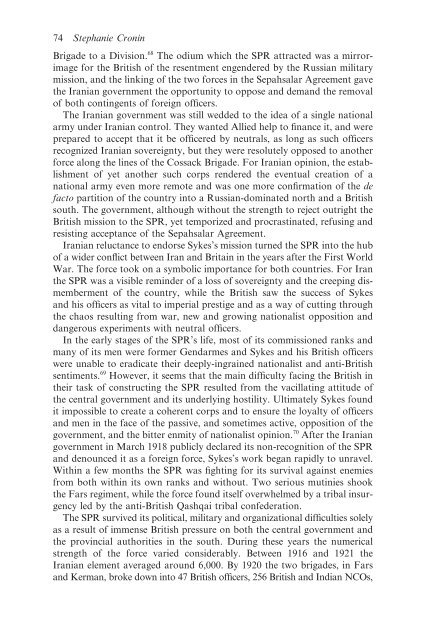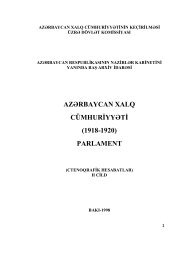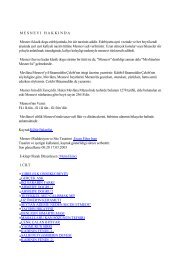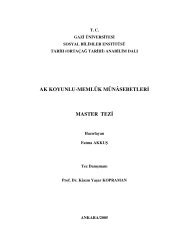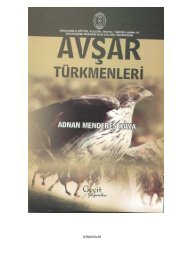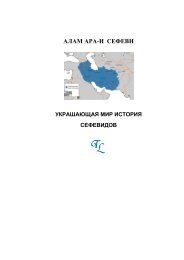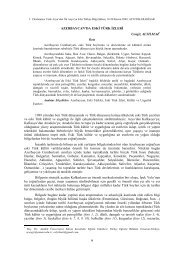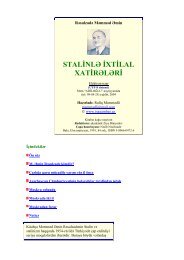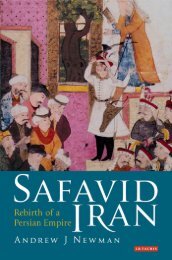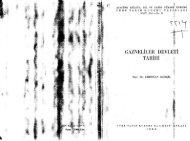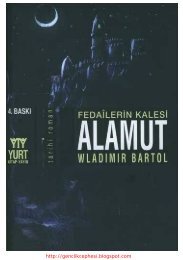War and Peace in Qajar Persia: Implications Past and ... - Oguzlar.az
War and Peace in Qajar Persia: Implications Past and ... - Oguzlar.az
War and Peace in Qajar Persia: Implications Past and ... - Oguzlar.az
- No tags were found...
You also want an ePaper? Increase the reach of your titles
YUMPU automatically turns print PDFs into web optimized ePapers that Google loves.
74 Stephanie Cron<strong>in</strong>Brigade to a Division. 68 The odium which the SPR attracted was a mirrorimagefor the British of the resentment engendered by the Russian militarymission, <strong>and</strong> the l<strong>in</strong>k<strong>in</strong>g of the two forces <strong>in</strong> the Sepahsalar Agreement gavethe Iranian government the opportunity to oppose <strong>and</strong> dem<strong>and</strong> the removalof both cont<strong>in</strong>gents of foreign officers.The Iranian government was still wedded to the idea of a s<strong>in</strong>gle nationalarmy under Iranian control. They wanted Allied help to f<strong>in</strong>ance it, <strong>and</strong> wereprepared to accept that it be officered by neutrals, as long as such officersrecognized Iranian sovereignty, but they were resolutely opposed to anotherforce along the l<strong>in</strong>es of the Cossack Brigade. For Iranian op<strong>in</strong>ion, the establishmentof yet another such corps rendered the eventual creation of anational army even more remote <strong>and</strong> was one more confirmation of the defacto partition of the country <strong>in</strong>to a Russian-dom<strong>in</strong>ated north <strong>and</strong> a Britishsouth. The government, although without the strength to reject outright theBritish mission to the SPR, yet temporized <strong>and</strong> procrast<strong>in</strong>ated, refus<strong>in</strong>g <strong>and</strong>resist<strong>in</strong>g acceptance of the Sepahsalar Agreement.Iranian reluctance to endorse Sykes’s mission turned the SPR <strong>in</strong>to the hubof a wider conflict between Iran <strong>and</strong> Brita<strong>in</strong> <strong>in</strong> the years after the First World<strong>War</strong>. The force took on a symbolic importance for both countries. For Iranthe SPR was a visible rem<strong>in</strong>der of a loss of sovereignty <strong>and</strong> the creep<strong>in</strong>g dismembermentof the country, while the British saw the success of Sykes<strong>and</strong> his officers as vital to imperial prestige <strong>and</strong> as a way of cutt<strong>in</strong>g throughthe chaos result<strong>in</strong>g from war, new <strong>and</strong> grow<strong>in</strong>g nationalist opposition <strong>and</strong>dangerous experiments with neutral officers.In the early stages of the SPR’s life, most of its commissioned ranks <strong>and</strong>many of its men were former Gendarmes <strong>and</strong> Sykes <strong>and</strong> his British officerswere unable to eradicate their deeply-<strong>in</strong>gra<strong>in</strong>ed nationalist <strong>and</strong> anti-Britishsentiments. 69 However, it seems that the ma<strong>in</strong> difficulty fac<strong>in</strong>g the British <strong>in</strong>their task of construct<strong>in</strong>g the SPR resulted from the vacillat<strong>in</strong>g attitude ofthe central government <strong>and</strong> its underly<strong>in</strong>g hostility. Ultimately Sykes foundit impossible to create a coherent corps <strong>and</strong> to ensure the loyalty of officers<strong>and</strong> men <strong>in</strong> the face of the passive, <strong>and</strong> sometimes active, opposition of thegovernment, <strong>and</strong> the bitter enmity of nationalist op<strong>in</strong>ion. 70 After the Iraniangovernment <strong>in</strong> March 1918 publicly declared its non-recognition of the SPR<strong>and</strong> denounced it as a foreign force, Sykes’s work began rapidly to unravel.With<strong>in</strong> a few months the SPR was fight<strong>in</strong>g for its survival aga<strong>in</strong>st enemiesfrom both with<strong>in</strong> its own ranks <strong>and</strong> without. Two serious mut<strong>in</strong>ies shookthe Fars regiment, while the force found itself overwhelmed by a tribal <strong>in</strong>surgencyled by the anti-British Qashqai tribal confederation.The SPR survived its political, military <strong>and</strong> organizational difficulties solelyas a result of immense British pressure on both the central government <strong>and</strong>the prov<strong>in</strong>cial authorities <strong>in</strong> the south. Dur<strong>in</strong>g these years the numericalstrength of the force varied considerably. Between 1916 <strong>and</strong> 1921 theIranian element averaged around 6,000. By 1920 the two brigades, <strong>in</strong> Fars<strong>and</strong> Kerman, broke down <strong>in</strong>to 47 British officers, 256 British <strong>and</strong> Indian NCOs,


